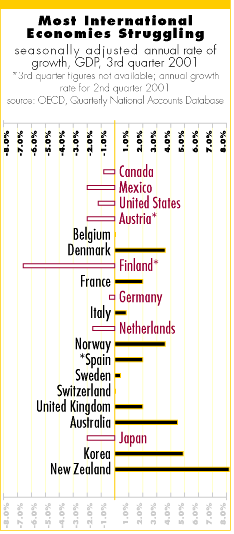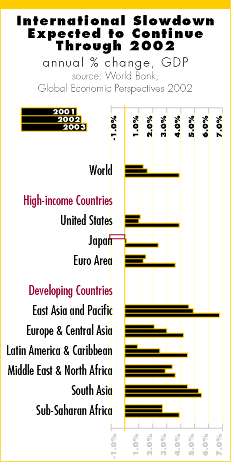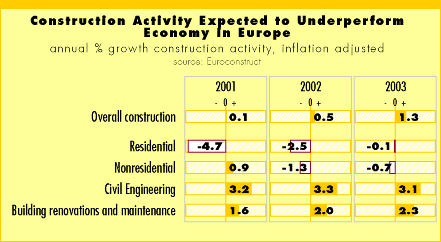
Developing countries offer more growth potential over short and long term

AIA Chief Economist
For much of the 1990s, the strength in the U.S. economy helped to prop up many international economies. In 2000, for example, the U.S. imported more than $1.5 trillion in goods and services, thereby pumping that level of spending into foreign markets. By the same token, the U.S. exported more than $1.1 trillion in goods and services last year. Because we are running a trade deficit—and have been every year since 1981—we are helping to fund international economic activity.
 We
might hope that our largess over the past two decades would be returned.
With the U.S. economy in recession since last April, it would be convenient
if the strength of foreign economies would provide extra opportunities
for the sale of U.S. goods and services abroad. Unfortunately, this is
not the case: while the U.S. economy is mired in recession, so are the
economies of many of our trading partners.
We
might hope that our largess over the past two decades would be returned.
With the U.S. economy in recession since last April, it would be convenient
if the strength of foreign economies would provide extra opportunities
for the sale of U.S. goods and services abroad. Unfortunately, this is
not the case: while the U.S. economy is mired in recession, so are the
economies of many of our trading partners.
Our major trading partners—Canada, Mexico, and Japan—are all dealing with economic problems as serious as those we're seeing in the U.S. Additionally, about half of the countries in Europe are either in recession or teetering on the brink. To sum up, very few industrialized economies are enjoying healthy growth at present.
Developing countries
poised for growth
The economic weakness among industrialized countries has significantly
sapped economic strength internationally. According to the World Bank,
the international economy increased only an estimated 1.3% in 2001, and
2002 isn't expected to show much improvement. Expectations include a weak
first half of the year for the U.S., Japan remaining in recession through
much of the year, and many fragile European economies weakening somewhat.
With weakness in most industrialized economies, developing countries offer more opportunity for growth, according to analysis by the World Bank. According to their projections, economic growth across developing countries should average about 2.9% in 2001 and 3.7% in 2002. However, the impact of the broader economic slowdown on the world's developing regions will vary significantly, often depending on trade patterns. Countries in Latin America and East Africa, with a large manufacturing sector and dependent on trade in manufactured goods, were the first to feel the impacts of reduced demand from the U.S. and Japan.
 At
the same time, the recent weakness in Europe has put pressure on the economies
of Latin America, Central Europe, and Sub Saharan Africa. South Asia,
which is less integrated into the world economy and has a healthy service
sector, has been less affected by global economic weakness. Oil revenues
in the Middle East and North Africa, which account for two-third of this
region's export revenues, form the basis for a favorable short-term outlook.
At
the same time, the recent weakness in Europe has put pressure on the economies
of Latin America, Central Europe, and Sub Saharan Africa. South Asia,
which is less integrated into the world economy and has a healthy service
sector, has been less affected by global economic weakness. Oil revenues
in the Middle East and North Africa, which account for two-third of this
region's export revenues, form the basis for a favorable short-term outlook.
Nonetheless, all of these regions are suffering
to some extent from the downturn in more developed economies. With a weaker
trade picture, a drop in tourism, and higher costs of capital, lending
in higher-risk developing countries has substantially slowed for all but
the best customers. Still, long-term prospects are for economic growth
in developing countries, which is expected to exceed growth in high-income
countries by almost half over the next 10–15 years.
European construction growth likely to
underperform the broader economy
Being a cyclical industry, the construction sector tends to outperform
the economy during periods of strong growth, and underperform the economy
during periods of weakness. The construction outlook for Europe is following
this pattern, according to forecasts released recently by Euroconstruct,
a European based construction-forecasting consortium. After growing by
almost 6% in 1999 and 2000, the European construction sector entered a
no-growth period in 2001 that is expected to continue through the end
of 2002. During this period, growth in the construction sector is expected
to underperform the economy. Beginning in 2003, the European economy is
expected to begin to rebound, and growth in construction activity will
more closely match growth in the economy.
Due to rising rates of unemployment and falling levels of consumer confidence, the residential sector in Europe is expected do be hit the hardest over the next two years. After declining by almost 5% in 2001, it is expected to decline by half that pace in 2002 before beginning to stabilize in 2003. The nonresidential market, which generally follows a similar pattern to residential activity, is not expected to see declines of the magnitude experienced by the residential side. Building renovations and maintenance, which tend to be less volatile than new construction, are expected to produce stable growth levels over the next two years. Civil engineering is expected to be the strongest construction sector over this period, because public spending should remain stronger than spending by households or businesses.

For U.S. architecture firms looking for design opportunities offshore, competition is likely to be keen. Decades ago, when one region of the world began to weaken, chances were that growth in another would offset this weakness. However, because our international economy is now more integrated, most areas fairly quickly feel the effect of a downturn in any another region.
Copyright 2002 The American Institute of Architects. All rights reserved.
![]()
|
|
|